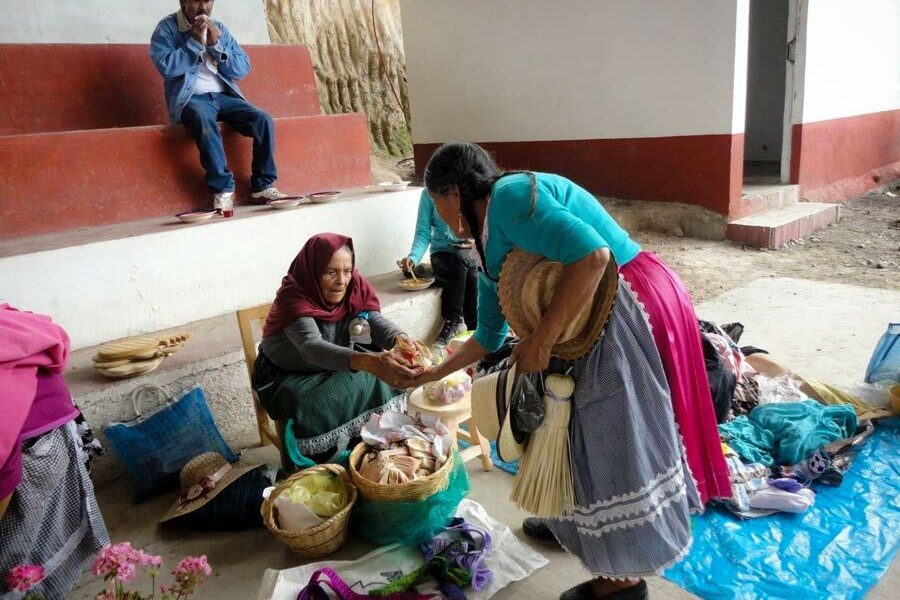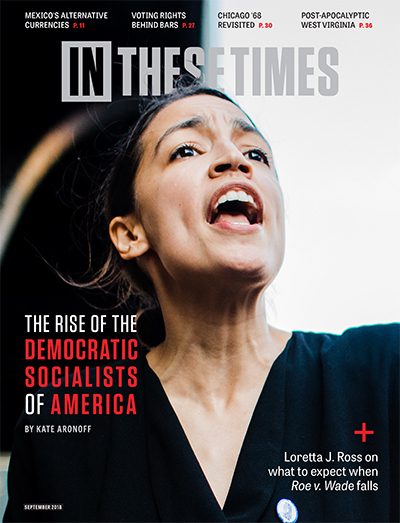Inside Mexico’s Anti-Capitalist Marketplaces
How some Mexicans are using barter and alternative currencies to build an economy beyond profit.
Ava Tomasula y Garcia

Two corn cakes for a loaf of bread. A liter of oats for an avocado and a bag of beans. An hour with a traditional healer for an hour of plumbing work. Ten mixiuhcas — the market’s currency of choice — for a jar of pickled carrots. Not a single peso in sight.
Vendors and buyers have gathered today in one of the city’s small urban gardens for this month’s Feria Multitrueke, an alternative economy and bartering market. Hipsters pushing organic quelite seeds mix with elders standing over steaming vats of hot chocolate and tamales. Women in aprons dole out tacos while their kids dart between stands. Shirts woven by a Mazahua indigenous women’s cooperative are displayed next to copies of the translated Complete Works of Rosa Luxemburg.
The air is alive with voices laughing, bartering and making sales. But these vendors aren’t ordinary vendors, and their buyers aren’t just customers, either. “We are all prosumidores here,” says Joaquina Flores, a member of the mixiuhca network. Prosumidor is a combination of the Spanish words for producer and consumer, highlighting the reciprocal nature of the market. “It’s solidarity,” Flores says. “This is about meeting needs, not generating wealth.”
The mixiuhca is one of many Mexican monedas comunitarias, communal or local currencies fostered since the 1990s, drawing on indigenous bartering practices. “Pesos generate violence, they fund wars, drug and human trafficking, GMO crops, international corporations, inequality,” says one prosumidor. “Community money doesn’t.”
In an exchange involving mixiuhcas, the buyer pays for a product or service using the mixiuhca and/or barter. As a commitment to the currency’s value, both buyer and seller sign the back of the mixiuhcas they use (which are about the size of an index card).
In this way, the currency gains credibility as it circulates, each signature acting as a “deposit” of confidence and value. Some monedas work like debt, others as compensation — it’s a form of credit, free of interest, based on trust. In addition to the monthly markets, mixiuhca users consult a registry of prosumidores for services, and can also use the currency at a variety of businesses that accept them.
Each prosumidor is given the same amount of mixiuhcas upon entering the community. Periodic checks ensure that everyone maintains about the same amount: If someone is lacking, the community tries to buy from them; if someone has too many, there is pressure for them to spend. Once a year, all prosumidores have to turn in their mixiuhcas, which are then redistributed evenly. “The monedas are meant to circulate, not accumulate,” Flores says.
Part of what makes Mexican communal currencies possible is the country’s larger economic context. The informal economy makes up over a quarter of Mexico’s GDP and employs over half its workforce. DIY vendors sell gum in the metro, a snack stand sits on every corner, shoes sprawl out on tarps and tlacoyos sizzle on sidewalk griddles.
The Mexican government says the informal market is an obstacle to “growth” and expanded social services, since informal businesses pay no taxes. But after enduring centuries of colonial violence, countless shocks from the neoliberal market and corporate-state-sponsored terrorism, many Mexicans doubt the informal economy is the problem. In fact, community self-sufficiency has long seemed the best bet for survival, from pre-colonization bartering practices to today’s tandas (neighborhood savings systems).
Alternative currencies have faced their share of persecution: The country’s first moneda, the bojá of Hidalgo state, was repressed; in cash-scarce Veracruz, the state has tried to crush the alternative tumin currency since its beginnings in 2010. (The tumin has prevailed, and today counts over 1,400 users.)
At this month’s Feria Multitrueke, people are hopeful. Claudia Caballero, a co-founder of the mixiuhca network, is promoting a new project: the Ecomun, an alternative national currency that will expand the solidarity economy by linking all community currencies in Mexico into an integrated market. This will enable, say, mezquite users in Guanajuato to sell to mixiuhca users in Mexico City, and will hopefully move them to the next step: alternative, community controlled “banking” able to provide autonomous financing outside the profit-driven peso system.
Flores smiles. “It will be neither micro nor macro, create neither isolation nor rampant growth, but companionship and togetherness.”






